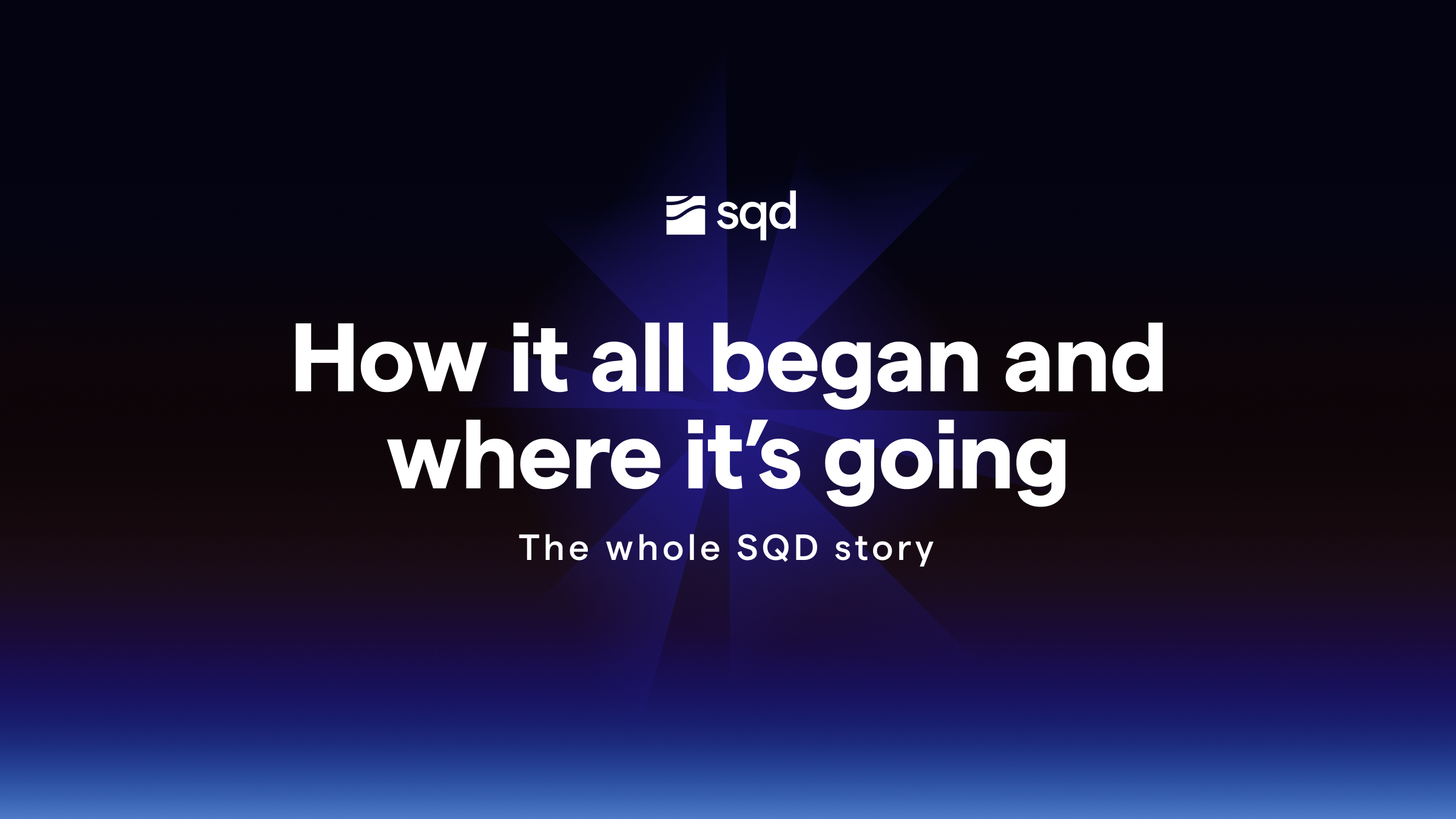The story of SQD

A holistic story of SQD
“Life can only be understood backwards, but it must be lived forwards.”
- Soren Kierkegaard
In hindsight, it appears obvious that SQD was going to make it to the 5-year mark that spells the death of the average startup. Yet while in the midst of it, none of us knew.
Until now, the whole story of SQD has been confined to the inner circles of our teams, investors, and a handful of attentive community members. This changes today as we unpack how it all started, what our primary motivation is, and why we’re far from being done.
Humble beginnings
Dmitry Zhelezov, one of our Co-Founders, was a math researcher always interested in crypto, but stayed sidelined until joining Messari as a community analyst. Eventually, on a Berlin rooftop, he made a connection that’d lead to Marcel Fohrman - the other SQD Co-Founder.

It wouldn’t be until one more bear market later that Dmitry had the idea for what later turned into SQD. After the typical trials and tribulations of the bear, Dmitry was working at Joystream, a project building decentralized YouTube on Substrate.
As part of the team responsible for querying data from blockchain, he quickly realized that this was a big problem waiting to be solved.
Outside of Polkadot, The Graph had established indexing as a million-dollar opportunity, yet no such thing existed for Substrate chains.
For a start, Dmitry joined a Web3 Foundation Hackathon, building the first MVP of a solution to accessing blockchain data.
He won, and the rest is history.
That’s what you’d expect, but things weren’t as straightforward. For one, he was still part of the other startup.
At the same time, a high-ranking indexing official had a Justin Bieber crashout seeing this hackathon submission, which seemed ridiculous at the time, but in retrospect, foreshadowed that we were really onto something.

Following the hackathon and before the official establishment of a company dedicated to this problem, a rival emerged: SubQuery. When Dmitry saw that there was someone else trying to fix this with — what he perceived as a subpar approach — he figured, might as well go all in.
The rivalry has since been set aside as SubQuery is now powered by SQD for their Solana product.
Serendipitously, he reconnected with Marcel around that time, and SQD (back then Subsquid) was officially established. With an 80% market share and a whitepaper outlining a much larger vision, the co-founders raised a seed round and launched what has become the data backbone of large crypto apps.
A little aside on the original name: "Sub” is referencing Substrate, and squid was chosen because the term appeared sexy to the founders, quoting Dmitry: it has a q in it and squids are nice.

Not so humble ambitions
Lesser-driven individuals might look at SQD and figure that we’ve already accomplished quite a lot and could be tempted to rest on our laurels. Especially if all you compare our growth to are other crypto infra projects, which go through boom and bust cycles.
Yet, while onchain is the start, we believe that changing the way we access data is much bigger than Web3.
Everything we do online is facilitated by large databases running quietly and smoothly in the background. All the big social and media platforms we use daily are only possible thanks to database technology’s advancements.

YouTube without a scalable database, unthinkable.
The current leading database companies all operate under the assumption that enterprises exist and that they want to store and manage their own data across servers without others meddling in. This works great for many things, but leaves one alternative untested.
What if we didn’t just allow vertical management of data, but opened it up to contributors?
Take Wikipedia. It would have never grown into what it has become without allowing anyone to contribute, while submission criteria and editors ensure a certain level of diligence.
Reject cold, soulless AI misinformation. Embrace human-centred, traditional Wikipedia misinformation.
— Neil Renic (@NC_Renic) May 13, 2025
Another example is Discogs, the largest collection of music recordings, including album covers and more, made possible by allowing anyone with an internet connection to contribute.
The above are providing knowledge in the form of textual data, easy to contribute to and learn from for humans, but they don’t offer simple access to the underlying data.
What if this principle of data gathering and curation were applied to raw, underlying data?
That’s in essence what we’re working to find out with SQD. Technology is driving advancements in scale and speed, but database companies blatantly neglect the social aspect.
We believe that blockchain is the right fit to bring both together: large-scale data contributions and shared ownership.
One way our founder describes the vision is as an Airbnb of databases. Owned collectively, and not by one company alone.
In the end, the goal is a global catalog of data accessible to anyone without permission or registration.

Current database technology is great for storing and querying, but it isn’t designed to facilitate a wide-open knowledge base.
How does data turn into knowledge? Through the combination of different data points, historical analysis, and the addition of context.
All of which is only possible when you have composable data.
That’s what SQD provides. The end goal then is to unlock new scales of knowledge by providing a network of databases that humans and AI interact with to make sense of the underlying data.
As such, we don’t compete with the existing Web2 stack like Clickhouse or DuckDB, quite the opposite. These are complementary, enabling people to retrieve and query data using tech they are familiar with from SQD.
Why does it matter?
The main motivation here? It’s about leveling the playing field and removing the information asymmetry.
In crypto, there’s not coincidentally much talk of cabals. The cards are mostly stacked against the small retail trader and in favor of the casino.

To this day, finance remains the largest field of crypto, making it a perfect place to bring our vision to life.
One step in that direction is via SQDGN. A world where everyone makes money trading is utopia, but at least we can help degens be more informed, gain insights, and be less likely to get rekt.
As more information moves onchain, the fields in which SQD contributes to alleviating information asymmetry will expand.
Why care personally?
For SQD Co-founder Dmitry, a big part of the appeal of crypto has always been that it’s not just about money, it’s about people and the social aspect. As a researcher, his main drive is to understand and fix complex problems.

He’s learned that the way to solve such problems is by bringing together experts from different areas and getting them to join forces in R&D to solve them.
SQD is a result of the founders' curiosity and their desire to address a problem that extends beyond web3 and, one could argue, beyond the borders of tech.
Last but not least, there’s one more question to answer:
How do we know whether we’re successful?
It’s pretty simple: the more people working on SQD, contributing to the ecosystem, and building with it, the better.
Once we’re not just one option, but the go-to place for data, then we’re successful.
“The ticket to the future is always open”
Vash The Stampede in Trigun
To chat about the SQD lore, join us on Telegram. And if you have questions that remain unanswered, you’ll also find answers there.
See you on the other app!